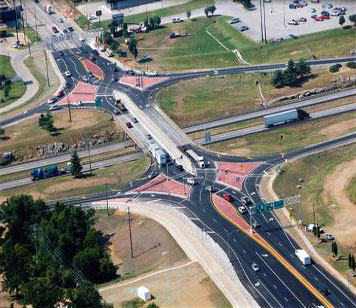D iamond upgrades are starting to become more common for highway interchanges in the United States — and motorists seem to be increasingly happy about it, as they are saving time and resulting in fewer accidents.
Having been opened for a year and a half, the interchange between Interstate 285 and Ashford Dunwoody Road in Atlanta has proven to be such a success that a second similar interchange had already been constructed; a third similar interchange is currently being built; and a fourth one — tied in with the Atlanta Braves professional baseball team moving to Cobb County in time for Opening Day of Major League Baseball in 2017 — is in the planning stages, according to this article written by Tonya Layman for the Atlanta Business Chronicle.
Known as a diverging diamond interchange, it allows motorists to freely turn left onto the ramps which access a main highway, which means that vehicles do not cross opposing lanes of traffic in order to access the highway. This requires motorists on the roadway to briefly drive on the opposite side of the road from what is customary. In the case of Ashford Dunwoody Road, traffic drives on the left side of the road instead of the right side when using the overpass to cross over the highway. On either side of the overpass beyond the entrance and exit ramps, opposite lanes of traffic intersect each other and are controlled by a traffic signal.
“Data shows the interchange has improved average travel time by 30 percent during the peak morning commute times and by 22 percent during the afternoon commute”, according to Yvonne Williams — who is the executive director of Perimeter Community Improvement Districts — as reported in the aforementioned article. “It has decreased stopped time by 61 percent in the morning and 42 percent in the afternoon.”
Additionally, converting existing interchanges to diverging diamond interchanges is quicker to complete and more cost effective than completely reconstructing an interchange.

What that means for you is reduced travel time in a vehicle; increased safety; and a savings of your tax dollars — depending on where you travel — especially as they have been appearing all over the United States, as shown in the map above. Click here to access a more detailed map with the exact locations of diverging diamond interchanges. However, these types of interchanges have reportedly been in the communities of Versailles, Le Perreux-sur-Marne and Seclin in France since the 1970s.
Have you driven on a diverging diamond interchange? If so, what are your thoughts?
Image courtesy of Advanced Transportation Solutions — also known as ATS/American.

